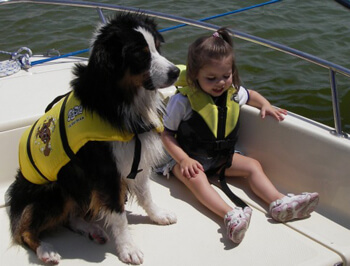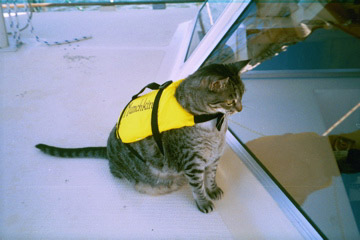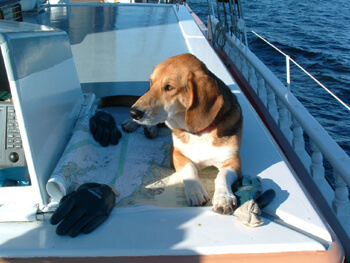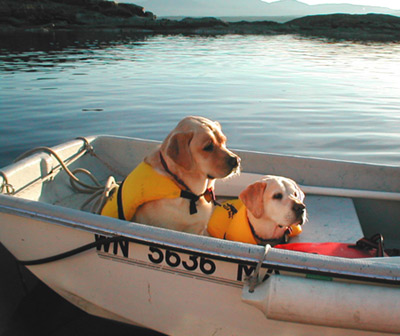By Stacy Mantle
Editor’s Note: For eight years, AZBW/WOT publisher Jim Allen and editor Carol Allen lived aboard in San Diego Bay. Their shipmate was a white Persian cat named “Popcorn,” who was an excellent boating companion. Many have asked us about having their pets onboard (pet boating safety!), and in response, we present this thorough article from petsweekly.com.
“In Memory Of Popcorn – Popcorn Will Be Missed”
Mil’s Popcorn wa s born Nov. 21, 1988. She left us on April 25, 2007. She was a shaded silver Persian, a beautiful, loving companion for nearly 19 years. “PC,” shown here in her PFD on the deck of Jim and Carol Allen’s Chris-Craft in San Diego, was a great boat cat, and more importantly, she was the essence of “Good Company.” We are thankful for the beautiful “Princess Cat” who graced our lives for so many years with unconditional love and loyalty.
s born Nov. 21, 1988. She left us on April 25, 2007. She was a shaded silver Persian, a beautiful, loving companion for nearly 19 years. “PC,” shown here in her PFD on the deck of Jim and Carol Allen’s Chris-Craft in San Diego, was a great boat cat, and more importantly, she was the essence of “Good Company.” We are thankful for the beautiful “Princess Cat” who graced our lives for so many years with unconditional love and loyalty.
Thank you, Miss Popcorn, for the wonderful memories; you are with us always. – Jim and Carol Allen
Dog overboard!
I heard the dreadful splash just seconds after our small dog slipped from the boat into the ocean below. Glancing over the side, I saw our tiny pug furiously doggie-paddling in the dark, cold sea. Kiang was struggling to reach the pier, but the frigid Pacific waters were quickly slowing him down and, despite the warm sun overhead, he was already shivering.
Suddenly, a large green fishing net surged through the water, scooping the tired pup from the sea in a frenzy of splashing and kicking. Luckily we were still docked, and the sea was not quite as frigid on this sunny day. Had it been winter, or in the open ocean, our pet may not have fared as well.

When we first thought about taking our pets along for a summer of cruising the Pacific Northwest, it was with little trepidation. We dreamt of watching our dogs chase seagulls through the early morning surf and seeing our favorite feline vigilantly standing guard on the bow, surveying the whales that surfaced near our yacht at sunset. It didn’t take long to understand that the reality of cruising with pets is much different than these sweet daydreams; but with preparation, planning and a lot of patience, we were able to make the dream a reality.
Ahoy, Mate!
Introduce your pets slowly to a life at sea (or even to prolonged periods on inland waters). We began with short rides in the dinghy. Our thinking was if they could handle a dinghy; they would be fine on a large boat. As it turns out, our dogs don’t like short rides in dinghies, preferring the yacht instead. Each pet is different.
If you find that your pet is susceptible to seasickness, consult your veterinarian before leaving the dock. The cats of several cruising friends exhibit symptoms such as excessive drooling, while our dogs tend to vomit in high seas. There are many options available for treating seasickness in pets, from over-the-counter treatments like Dramamine to prescription medications.

Check with your veterinarian before administering anything to your pets. Keeping your pets restrained near the center of the boat where there is less motion while underway will also help.
Finally, be sure to thoroughly examine your pet’s health prior to leaving. You should obtain blood work and a stool sample analysis to check for heartworm and other parasites, and since you could be going to an area that is ripe with these issues, put your pet on heartworm medication prior to leaving. It only needs to be administered once per month and it could save your pet’s life.
Basic training is also an important cruise precursor. You must teach all pets to wear harnesses rather than collars, and to stay on-leash. A sturdy harness will allow you more control over your pet while walking, and will make it much easier to pull them out of the water if required.
Train your pet to obey simple commands such as come, board, off boat, drop, and stay. Using positive reinforcement and clicker training, even cats can be trained. Many places have leash laws for all species, and not obeying this law can result in a large enough fine to put a damper on your cruising vacation.
Check www.pettravel.com for your state’s requirements, and call ahead to the next marina for their regulations as they may differ from the state. Another costly issue is not cleaning up after your pet in marinas. We found it easiest to carry small plastic sandwich bags that can be easily sealed and disposed of.
While You Are Docked — Welcome Aboard!
Docked boats provide a perfect learning opportunity for pets, and this is the time to establish a routine. We immediately let our pets know when they were allowed outside, where it was appropriate to eliminate, and the difference between playtime and naptime.
This is also the time to establish a boarding protocol. Ramps can be purchased to help a pet board safely, and everyday bathroom mats can provide footing on the slick fiberglass of a freshly waxed boat while docked. A floating dog ramp is a great investment for your pets safety.
 Keep your pet’s health records handy as you could be asked for them at any time. A health certificate states the animal was in good health at the time of the visit to the veterinarian, its breed, name, date of visit, and any health concerns. If you’re sailing abroad, European countries require an EU998 form which can be provided by your veterinarian, so plan in advance.
Keep your pet’s health records handy as you could be asked for them at any time. A health certificate states the animal was in good health at the time of the visit to the veterinarian, its breed, name, date of visit, and any health concerns. If you’re sailing abroad, European countries require an EU998 form which can be provided by your veterinarian, so plan in advance.
Keep current pictures of your pets handy in case they become lost while docked, and always keep copies of your pet records in a separate location. Avian Flu has caused problems for many a boating bird-owner, so be sure to check the most recent legal requirements before embarking as these regulations change constantly.
Ensuring that your pet has proper identification is imperative. There are a number of different types of ID forms available, including a new “electronic” collar that stores your pet’s information on a waterproofed flash drive. A service that we use is available in Canada and the U.S. called 1-800-LostDog. With a 98 percent recovery rate within the first 48 hours of a pet missing, this is one of the more efficient methods we have found for tracking our pets.
Microchipping your pet is important; yet keep in mind that it is best to combine microchipping with an ID tag. Be sure to have a cell phone registered with any ID in case your pet is found. We know of cases where the owners were called on their home phone, but they didn’t receive the message for two months as they were out cruising. It is also wise to register the phone number of a friend or family member you trust.
Your Pets and Cruising – The Salty Dog
We found out early on in our cruising career that slick boat decks and pets do not mix when our dog slipped overboard while trying to avoid a particularly hostile pelican. We also learned the importance of a harness as we awkwardly hauled him aboard and Kiang slipped out of his collar.

Keeping pets safely aboard is a challenge, but one that can be met. We ultimately purchased rubber-soled boots for our pets, but remember that dogs “sweat” through their paws, so be careful they don’t overheat while wearing boots.
A new product called “Paw-pads” has just been released which affix to the bottom of your pet’s foot for more traction. Placing lifeline mesh netting around your boat will help keeps your pets and your gear aboard.
For smaller pets like our Yorkshire terrier and pug, a large fishing net makes pulling our pets back on board a lot easier. For larger pets, you will need to develop a rescue plan that should be practiced until you and your pets are comfortable.
 A “self-rescue” plan is best and can center on a floating dog ramp. Bundles of rope hanging safely from your boat will provide a lifeline for cats, and creates one more reason why you should never declaw a cat, particularly if they are serving as shipmates.
A “self-rescue” plan is best and can center on a floating dog ramp. Bundles of rope hanging safely from your boat will provide a lifeline for cats, and creates one more reason why you should never declaw a cat, particularly if they are serving as shipmates.
When at sea, always keep your pet in a confined area, tethered or wearing a high-quality PFD (Personal Flotation Device). Remember that even if your pet is an excellent swimmer, panic can quickly paralyze him or her in the event of a fall, just as it happens with people.
Pets can also slip off the back of a large boat without being noticed. A brightly colored PFD can mean the difference between a wet pet and a catastrophe. PFDs should have a handle built in to the back of the device for easy lifting, and it must be sized to fit your pet correctly, so be sure to measure your pet according to the manufacturers guidelines.
Be sure that your pets are accustomed to wearing them on land and sea. You might also consider a flashing safety light for your pet’s harness, (we also use ours to locate our pets on the boat at night).
Avoiding A Cat-astrophe
 We found it useful to take a first-aid course designed for pets, which many veterinarians and humane societies offer. You never know what you will run across at sea!
We found it useful to take a first-aid course designed for pets, which many veterinarians and humane societies offer. You never know what you will run across at sea!
One of our fellow yachtsmen had an emergency with their dog, and was forced back to Seattle for emergency treatment. Don’t be shy about using your radio — in this case, a nearby boater overheard their doggie distress call and was able to contact a veterinarian on land for immediate advice on stabilizing their pet.
First aid courses for pets cover general medical advice, CPR, basic anatomy and a number of other important topics. This will help you determine what constitutes an emergency and how to resuscitate your pet in case of accidental drowning.
Teach your pets about water. We began with swimming lessons in a pool with our pets, particularly while they wore a PFD. Teach them the entry and exit ports and how to be comfortable in water.
For larger pets, you should consider picking up a floating pet ramp that can be easily attached to your boat’s swim deck and teach them to use it correctly. Pets should always wear lifejackets while underway.
Pets are susceptible to sunburn, damage to their eyes from the sun reflecting off of water, and seasickness. It’s important to plan ahead for these issues. Apply sunscreen to your pet’s nose, and if they are light-colored, plan on adding a lot.
Keep your pet’s eyes shielded with visors or even sunglasses, particularly when you are cruising — it’s more than just a fashion statement.
Since docking is a high-stress time for captains, it is important to keep your pet tethered with one or two of their favorite toys, ours prefer their favorite blanket. A loose dog on the bridge is not recommended while attempting to dock an expensive boat. The same holds true for cats, birds and other pets. Keep your attention on the task at hand.
The Scoop On Poop (Or “The Poop Deck”)
Potty-training your pet is perhaps the most challenging adventure at sea. Pets simply do not know what to do and often, neither do the owners. We are still struggling with our two dogs, and we know of a few owners who have not been able to potty-train their pets after three or more years of boating; so don’t become discouraged if it takes some time.
There are several things you can do to make potty training easier on you and your pet.
Create an area on the boat that is designated for your pet. For dogs, there are a number of products available ranging from “self-cleaning” Astroturf to fresh sod that can be replaced every few days.
We use a unique product called “Puphead” from Pupgear Corporation. The treated turf instantly attracts dogs to it with its unique scent. The urine drains into a tray, and waste can be disposed of easily.
We have found that animals have different preferences in this area. Smaller pets can easily be litter-box trained, or you can even train them to use the lavatory if you are so inclined. No matter which method you choose, be sure that your pet understands what is expected.
Docking — The Scuttlebutt!
Every harbor is different when it comes to allowing pets. Check the local guidelines through www.pettravel.com before you arrive, as occasionally pets are not allowed on shore. Breed bans are becoming more popular, so be sure to ask around when you plan your trip.
While dogs less than three months of age are not expected to have their rabies vaccination, they will still need to produce a health certificate from a veterinarian stating that the pet is healthy.
Pets over three months are generally required to have their rabies vaccination. In nearly all cases, you will be asked to produce a health certificate that lists your pet’s age, breed, vaccinations and overall health. You will also be asked for your pet’s vaccination records. It is important to keep these records ready for inspection at all times. Remember to keep duplicate copies at home for safekeeping.
When entering Canada, you will need to obtain clearance from the customs inspector. Canada requires that all pets three months or older entering from a “non-rabies free” region have their rabies vaccine.
Keep in mind that Canada also has a ban on pit bulls. If you’re traveling with a pit bull, do not expect to dock in Canada. For more information, refer to the Canadian Food Inspection Web site.
When entering the United States., there is no rabies vaccination requirement for cats; however, dogs must be vaccinated at least 30 days prior to entry with the exception of dogs three months or younger, and those who have been in a “rabies-free” country for six months prior to entry.
Find more information online at the USDAl. Hawaii has its own set of rules, and all pets arriving on the island will have a mandatory quarantine of 130 days.
P’Etiquette
There is nothing so disrupting as a barking dog, and this has perhaps been our greatest challenge, as our small dogs love to bark at everything. When you leave your pets aboard, be sure you have trained them to stay quiet.
There are many ways of addressing behavior issues, but they all require determination and patience. Don’t be afraid to contact a local trainer for help. If you have a pet that is prone to attacking other animals or biting, keeping it muzzled while you are walking or while docked will help you avoid a lawsuit.
In the event that your pet does happen to unintentionally annoy a fellow boater in a nearby slip, be sure that you are proactive in addressing the issue by apologizing and discussing the matter. It is important to stay cordial with those with whom you cruise.
The Bottom Line
The bottom line is that you should plan for your pets with the same energy that you use to plan for visiting children. Remain vigilant at all times, outfit your pets with the proper equipment, use sunscreen and other protection and if possible, have your pet wear a visor to protect their eyes.
And for those who are leery about cruising with their pets, we say, “Forget your doubts and go for it!” Remember that some pets may take longer than others to make great cabin-mates, but with enough time and patience, you can help your pet adapt to life at sea. You can have the best of both worlds.
Is it worth the energy? We know it is, but if you aren’t completely convinced just ask those who come to your boat every day for their “furry friend fix” because they left their own pets behind in a boarding facility.
Packing For Pets
PFD, fitted for each of your pets (even cats)
Pet First Aid Kit
Non-spill dishes
Plastic, sealing food container
Bach’s Rescue Remedy (to calm animals)
ComfortZone / Feliway diffusers (to calm animals)
Favorite treats and toys
Micro fiber blanket for “wet pets”
Harness & Collar
Leash
Plastic bags or pooper-scooper
Pet Bed (if applicable)
Brushes & Combs
Health and Rabies certificates
Vaccination records
Medications and copy of prescriptions
Naturopathic remedies for seasick pets
Scratching posts (cats)
Litter box or mat (both)
Rubber-soled boots and/or “pawpads”
Emergency / contingency plan
Disinfectant and carpet cleaner
Flashlight or Puplight
Three days supply of pet food
Emergency contact list
ID tags and microchip information
Your Pet First Aid Kit
For dogs: These are some of the suggested items.
(1) 4″x 4 yd. Stretch Gauze
(2) 5″ x 9″ Trauma Pads
(2) 3″ x 3″ Sterile Pads
(2) 2″ x 2″ Sterile Pads
(1) 4″ x 5 yd. Vet Wrap
(1) 4 oz. Eye & Skin Wash
(1) Pair Scissors
(10) Cotton Swabs
(1) 1/2 fl. oz. Liquid Styptic
(2) Insect Sting Swabs
(2) .9 gr. Hydrocortisone Cream
(1) feeding syringe Two 1 gr. Triple Antibiotic Ointment
(2) Green Soap Towlette
(2) Antiseptic Wipes
(1) 1″ x 2 1/2 yd. Adhesive Tape
(1) 1 oz. PVP Iodine
(1) Handwipe
(1) 4″ Plastic Forceps
(1) Pair Latex Gloves
(1) Care Card
(1) CPR Card
(1) bottle Betadine
For Cats
 Make your own first aid kit! These are some of the suggested items.
Make your own first aid kit! These are some of the suggested items.
(1) Bottle Powdered Styptic
(1) Oral Feeding Syringe
(1) Pair Latex Gloves
(1) 1″ x 6 yd. Sterile Gauze
(1) 1 oz. Bottle of Eye & Skin Wash
(1) Pair Plastic Forceps
(2) Pkgs of Hydrocortisone Cream
(2) PVP Iodine Swabs
(2) Insect Sting Swabs
(1) Roll 1/2″ x 2.5 yd. Adhesive Tape
(1) 5″ x 5″ x 2 12″ Poly Container
(1) Feline CPR Instruction Card
(1) bottle Betadine 2 – Packages 2″ x 2″ Gauze Pad
(2) Packages 3″ x 3″ Gauze Pad
(1) Pair Scissors
(1) Hand Wipe
(2) Antiseptic Towelettes
(10) Cotton Swabs
(2) Green Soap Towelettes
(1) Feline Care Card (detailed first aid instructions)
(1) Emergency Information/Content Card
(2) Pkgs of Triple Antibiotic Ointment
Arizona – Lost Our Home Pet Rescue
New Mexico – Fur and Feather Animal Assistance
































“Everything was put together perfectly. It’s difficult to say what was the best part of the article. It was all put together so well”
[…] beforehand. Even if they do, it’s highly recommended to get them a doggy life jacket. Brush up on pet boat safety principles and follow them […]